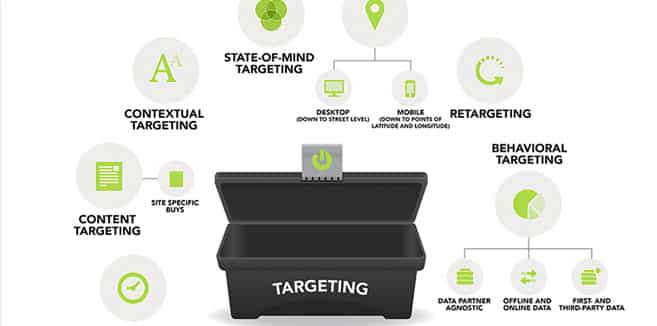It hit me the other day that many people have heard all the different buzzwords surrounding targeting, and may have even read a little about them, but most don’t truly understand it. Even many who work full time in the marketing industry are confused about all the different options available today. Thanks to the fact that new targeting methods are being developed and tested all the time, many people who think they are experts aren’t even aware of some of the latest targeting types out there.
Whether you are just starting to look into targeting options, or you are a seasoned professional, you can always learn more about this effective marketing tool. The following targeting options are a mix between tried and proven methods and some of the latest methods that have been developed by the fine folks at engage:BDR. Take a few minutes and learn about them, and how they can be used to improve your overall marketing strategy.
Geo-Targeting
Geo-targeting is perhaps the best known of all the options that will be covered. The fact is, however, most people only really understand that it involves targeting people based on their geographic location. While that is true, geo-targeting today is a little more complex than that. With desktop computers, geo-targeting can target people all the way down to the street level. This means marketers can run ads for businesses that are within walking distance, a bike ride away, or a short drive.
For those who are on mobile devices, geo-targeting allows you to target users down to the points of latitude and longitude. For example, you can have an ad triggered for a restaurant as soon as the user gets within a set number of feet from the establishment itself. This is a proven way to achieve high conversion rates for many different industries.
Day-and-Time-Parting
Day-and-Time-Parting is more than just choosing which ads to show at what time of the day or what time of the week, though that is a part of it. When done properly, you can use this targeting method to adjust the bids for ad placement based on the expected return on investment. For example, if you’re marketing for a dating website, ads displayed on a Friday afternoon are likely going to convert far better than those on a Wednesday morning. That being said, however, all traffic is worth something.
Using day-and-time-parting you can adjust the CPC or CPM for ads based on when they are being seen. This can help to not only save you money, but also allow you to effectively send a steady stream of quality traffic to your site.
Content Targeting
Many people confuse content targeting with general keyword targeting or paid inclusion marketing. The difference, however, is important. Content targeting works by matching the ad content with the overall content on the site. When this is done properly, the content of the advertisement itself will properly match the content of not only the search query that users type in, but also the rest of the page. This allows the ad to benefit from the established authority of the site, which can help to drive clicks and increase overall conversion rates significantly.
Contextual Targeting
Contextual targeting has been around for a very long time, but thanks to continuous advancements, it is still very effective. This type of ad gets triggered based on the other content on the page. If the webpage that is being displayed is about camping, for example, an ad for sleeping bags may be triggered because it fits in with the overall context of the page.
Thanks to advanced algorithms, contextual targeting today can achieve very high conversion rates. Companies like engage:BDR and others have data from years of real world marketing campaigns, so they can accurately predict which types of ads will convert best based on the context of the page.
Retargeting
Ad retargeting is quickly becoming one of the most popular and most effective forms of advertising today. It works by specifically targeting people who have come to a site to look at a product, but then browsed away without buying. The most common example of this comes from Amazon.com. If you go to Amazon and view a new dress that you’re thinking about buying, but then you leave the site without making a purchase, you will almost certainly see the same dress in your ads for some time to come.
Retargeting can be very precise as well, allowing marketers to choose how long to wait before they start showing the ads, and how long after the initial view to show the ad. Ad retargeting is one of the newer technologies, but it is really changing the marketing world today.
Behavior Targeting
Behavior targeting is very effective because it can predict whether or not someone is in a ‘buying mood.’ The technology looks at user behavior including things like what they have been searching for, how long they have been staying on each page, the types of things they are doing on the web and more. Based on that information, the targeting algorithm technology can determine which ads are likely to perform the best, and display those. This is a fairly complex system, but it has been shown to be very effective.
Overall Media Buying Targeting
While each of these types of targeting can be extremely effective on their own, the real power can come when you combine two or more of them together. For example, using geo-targeting it is possible to narrow down the potential ads for local businesses that should be displayed. Then, based on the day-and-time-parting, it can be further narrowed to just one or two. For a Friday evening at 6:30, for example restaurant ads are likely to convert extremely well. Add on the other forms of targeting and you can get a system that converts at much higher rates than any one form of targeting could on its own.




